Nasir ol Molk Mosque
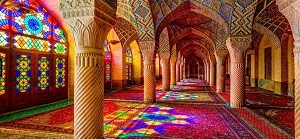
The Nasir ol Molk Mosque (Persian: Masjed e Nasir ol Molk), also known as the Pink Mosque, is a traditional mosque in Shiraz, Iran. It is located at the district of Gowad-e-Arabān, near Šāh Čerāq Mosque.
The mosque includes extensive colored glass in its facade, and displays other traditional elements such as the Panj Kāse (“five concaved”) design. It is named in popular culture as the Pink Mosque, due to the usage of considerable pink color tiles for its interior design.
Imam Mosque (Shah Mosque)
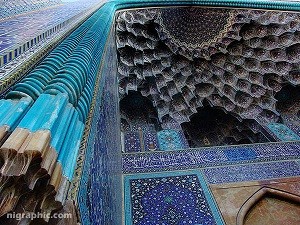
The Shah Mosque, also known as Imam Mosque , renamed after the 1979 Islamic revolution in Iran, and Jaame’ Abbasi Mosque, is a mosque in Isfahan, Iran, standing in south side of Naghsh-e Jahan Square. Built during the Safavid period, ordered by the first Shah Abbas of Persia. The mosque has also been called Jameh Mosque of Isfahan over the course of years.
It is regarded as one of the masterpieces of Iranian/Persian Architecture and an excellent example of Islamic era architecture of Iran. The Shah Mosque of Isfahan is one of the everlasting masterpieces of architecture in Iran. It is registered, along with the Naghsh-e Jahan Square, as a UNESCO World Heritage Site. Its construction began in 1611, and its splendor is mainly due to the beauty of its seven-colour mosaic tiles and calligraphic inscriptions. The mosque is one of the treasures featured on Around the World in 80 Treasures presented by the architecture historian Dan Cruickshank.
The mosque was depicted on the reverse of the Iranian 20,000 rials banknote.
Sheikh Lotfollah Mosque
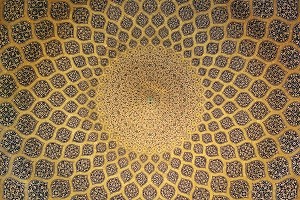
is one of the architectural masterpieces of Safavid Iranian architecture, standing on the eastern side of Naghsh-i Jahan Square, Isfahan, Iran.
Construction of the mosque started in 1603 and was finished in 1619. It was built by the chief architect Shaykh Bahai, during the reigh of Shah Abbas I of the Safavid dynasty.
Jame Mosque of Yazd
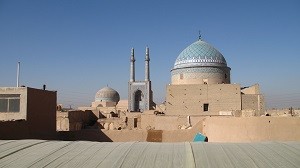
is the grand, congregational mosque (Jāmeh) of Yazd city, within the Yazd Province of Iran. The mosque was depicted on the obverse of the Iranian 200 rials banknote.
Goharshad Mosque
is a former free standing mosque in Mashhad of the Razavi Khorasan Province, Iran, which now serves as one of the prayer halls within the Imam Reza shrine complex.
It was built by the order of Empress Goharshad, the wife of Shah Rukh of the Timurid Dynasty in 1418 CE. The architect of the edifice was Ghavameddin Shirazi, who is responsible for so many of Shah Rukh’s great buildings, with the architectural and decorative manpower supplied from Shiraz and Isfahan.
The mosque underwent some renovations during the Safavid and Qajar eras. It has four iwans and a courtyard measuring 50 m × 55 m (164 ft × 180 ft), as well as several shabestans.
The double layered dome of the mosque was severely damaged in 1911 in bombings by troops of the Russian Empire.
Agha Bozorg mosque
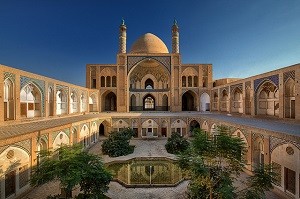
is a historical mosque in Kashan, Iran. The mosque was built in the late 18th century by master-mimar Ustad Haj Sa’ban-ali. The mosque and theological school (madrasah) is located in the center of the city.
Agha Bozorgh Mosque was constructed for prayers, preaching and teaching sessions held by Molla Mahdi Naraghi II, known as Āghā Bozorgh.
Al-Nabi Mosque, Qazvin
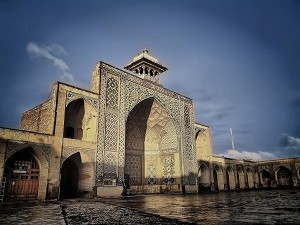
is a famous mosque in Qazvīn. The mosque has an area of about 14,000 m², and bears inscriptions indicating that Fath Ali Shah of the Qajar dynasty was the founder of the mosque. Other sources however indicate that the mosque has been in existence since the Safavid period. It is now believed that the architect of the structure was Ustad Mirza Shirazi with the date of construction being 1787.
Jameh Mosque of Qazvin
is one of the oldest mosques in Iran, and is the grand, congregational mosque (Jameh Mosque) of Qazvin, in Qazvin Province, Iran.
The oldest part of the mosque is said to have been constructed by the orders of Harun al-Rashid in 807CE. Later additions were made, the last being during the late Safavid era. The double layered main dome of the mosque is from the Seljuk era, and is locked to the public. It houses some precious examples of relief calligraphy from medieval times. Renovations have also been carried out on many sections of the mosque.
The foundation of the mosque is laid on a Zoroastrian fire temple.
In spite of the devastating Mongol invasion, the mosque still stands today in its full glory. It is still in use. Parts of the mosque have been turned into a public library.
The mosque also contains a Shabestan and Ab anbar, both now under the protection of Iran’s Cultural Heritage Organization.
Part of the mosque got on fire January 28 2013 and that resulted in the historic tomb to be completely destroyed.
Blue Mosque, Tabriz
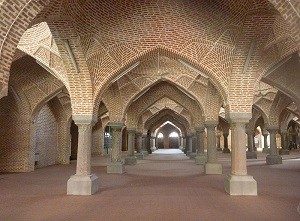
is a famous historic mosque in Tabrīz, Iran. The mosque and some other public buildings were constructed in 1465 upon the order of Jahan Shah, the ruler of Kara Koyunlu.
The mosque was severely damaged in an earthquake in 1779, leaving only the iwan (entrance hall). Reconstruction began in 1973 by the late Reza Memaran Benam under the supervision of Iranian Ministry of Culture. However, the tiling is still incomplete.
